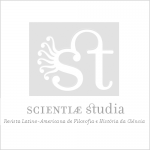Formas do vivo e no vivo: imitar e/ou reproduzir a vida
Vol. 6, No. 1 • Scientiae Studia
Autor: Anne Marcovich
Resumo:
As questões relativas às formas e à morfologia adquiriram depois do século xviii uma posição central nas ciências e, particularmente, na biologia. Desde 1890, as formas surgiram na bioquímica a partir da noção de especificidade (fala-se da adequação entre moléculas como daquela entre uma chave e uma fechadura). As diferentes orientações na biologia (particularmente depois da revolução da biologia molecular, do desenvolvimento da biologia sistêmica, da biologia sintética e dos trabalhos claramente orientados para as escalas nanométricas) produziram significações diferenciadas das noções de forma e de especificidade. As diferentes perspectivas, nas quais elas são utilizadas, principalmente, na questão das fronteiras entre vivo e não vivo, entre natureza e artifício, ou, ao contrário, nas quais elas são eliminadas, substituídas, por exemplo, pelas noções de informação e de código, poderiam fornecer a chave para compreender a epistemologia profunda da pesquisa nesses domínios e os "paradigmas" que congregam pesquisadores que trabalham originalmente em comunidades científicas distintas. As análises aqui propostas apóiam-se principalmente na idéia de invariabilidade dos conceitos e das idéias que, mais ou menos explicitamente, possam assemelhar-se a princípios organizadores das atividades científicas.
Abstract:
Questions related to forms and morphology acquired a central position in the sciences after the xviiith century, particularly in biology. Since 1890, forms entered into biochemistry starting from the notion of specificity (fit among molecules is said to be like that of key and lock). Different orientations in biology (particularly after the molecular biology revolution and the development of systemic biology, synthetic biology and works clearly oriented to the nanometric scales) have attributed different meanings to the notions of form and specificity. The different perspectives on the one hand, those in which these notions are used, mainly in connection with the question of boundaries between the living and the non-living, and between nature and artificial and, on the other hand, those in which they are eliminated, replaced, for example, by the notions of information and code could provide the key to understanding the deep epistemology of research in these areas, and the "paradigms" that bring together researchers who begin their work in distinct scientific communities. The analysis proposed here is mainly based on the idea of invariability of concepts and ideas that, more or less explicitly, can resemble organizing principles of scientific activities.
DOI: http://dx.doi.org/10.1590/S1678-31662008000100006
Texto Completo: http://www.scielo.br/scielo.php?script=sci_arttext&pid=S1678-31662008000100006&lng=en&nrm=iso&tlng=pt
Palavras-Chave: Biologia molecular, Biologia sistêmica,Biolog

Scientiae Studia
Associação Filosófica Scientiae Studia - Revista Scientiae Studia
